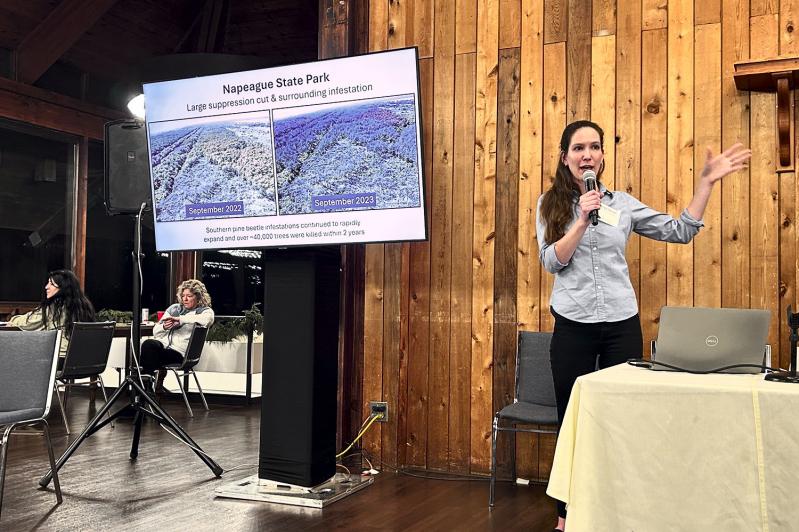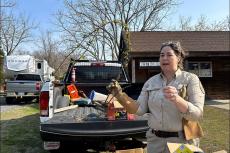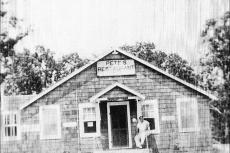The work being done to respond to damage from the southern pine beetle on Napeague and in Hither Hills State Parks will continue over the course of “several winters,” according to Lynn Bogan, assistant deputy director for stewardship at the New York State Department of Parks, Recreation, and Historic Preservation.
The department’s next steps, Ms. Bogan said at a public meeting at Montauk Downs State Park last Thursday night, are to hire a certified burn boss to “create a fuel mitigation and fire management plan” and to “propose and prioritize treatments for fuel mitigation and fire management.” The burn boss will also continue to collaborate with local fire departments and the New York State Department of Environmental Conservation to ensure everyone is on the same page.
The large-scale plan will also entail cutting down trees that will be piled and safely burned. The goal is to create buffer zones between areas of pines so that the beetle will have a harder time moving through the parks. The department refers to these dead and downed trees as “fuel.”
Ms. Bogan was one of many speakers at last Thursday’s meeting. Also present were George Gorman, regional director of the department, and Becky Sibner, a forest health specialist, who painted the full picture of what has happened to both Napeague and Hither Hills State Parks since the beetle was first discovered there, as well as how the department has responded.
“We were told that it was probably a losing battle,” Mr. Gorman said of the initial approach to fighting the beetle, “but we had to do it to try and prevent it from spreading any farther.”
The beetle is native to the Southern United States but has steadily migrated north. “Our winters are getting warmer because of climate change,” Ms. Sibner said, “and as a result the beetle has been able to really expand its range.” This species is able to spawn multiple generations a year, and with the warmer summers come more and more generations.
The first step the department took were “suppression cuts” in 2022 focused on every infected tree and a buffer zone of healthy trees to stop the spread of the beetle. “You’re trying to knock down the populations,” Ms. Sibner explained, “and create large enough space that they then won’t move to healthier trees.”
This largely failed and forced the department to reassess its strategy going forward. Additionally, the northern long-eared bat was placed on the endangered species list in 2022, limiting the windows of when trees can be cut to between Dec. 1 and Feb. 28, and the month of June.
For instance, the department cut down many dead trees along the Paumanok Path and Promised Land trails in 2024 but the trees had to be left on either side of the trails because of the small window for cutting.
“Is there any evidence of natural resistance?” Andy Harris, a Montauk resident, asked during the question-and-answer session following the presentation. The short answer was no.
“The speed at which this beetle comes and hits the pines, there’s not time to develop any natural resistance,” Ms. Sibner replied, also noting that healthier trees are naturally more resistant but enough beetles can overcome this. The beetles rely on pheromones to call other beetles to trees, where the swarm can kill a tree in about two months. At full force, the beetle infestation can progress at a rate of about 120 feet per day.
The forced reassessment led the department to shift from rapid response and containment to long-term management and mitigation. Ms. Sibner shared the department’s three goals for management: “reduce and mitigate threats to public safety, protect and promote rare and vulnerable species and natural communities, and strengthen ecosystem resiliency to pests and disease.”
The New York State Department of Transportation also assisted in 2023 by removing trees along Montauk Highway to create a buffer zone there. The biggest management task the Parks Department has undertaken is the creation of two miles of 25-foot-wide fuel breaks where the forests meet private property, which also protects those properties in case of a fire.
This project began in December 2023 and was completed in February 2024. The fire breaks were created in consultation with the D.E.C. and local fire departments to make sure the breaks were wide enough for two vehicles to pass each other in the event of an emergency.
The department is also working on removing dense shrubs from the ground in many areas of the parks. This acts both as fire prevention and creates more open space where the beetles’ pheromones can be lost. In the event of a fire, the dense undergrowth could carry it through the park quickly and potentially allow it to spread to the canopy. Although it may look barren in those areas, those shrubs will grow back, Ms. Sibner said.
“It is not a one-time management . . . we’ll probably mow them again.”
In the audience were various state and local elected officials including Assemblyman Tommy John Schiavoni, Suffolk County Legislator Ann Welker, East Hampton Town Supervisor Kathee Burke-Gonzalez, and Councilman David Lys. “Can the community plan on any fuel reduction techniques this springtime?” Mr. Schiavoni asked.
Ms. Sibner said that the downed trees along the Paumanok Path will begin to be piled up, and, according to Ron Rausch, deputy commissioner for environmental resources, the burning of the piles “will likely not be before the fall,” as the department is now searching for a burn boss.




